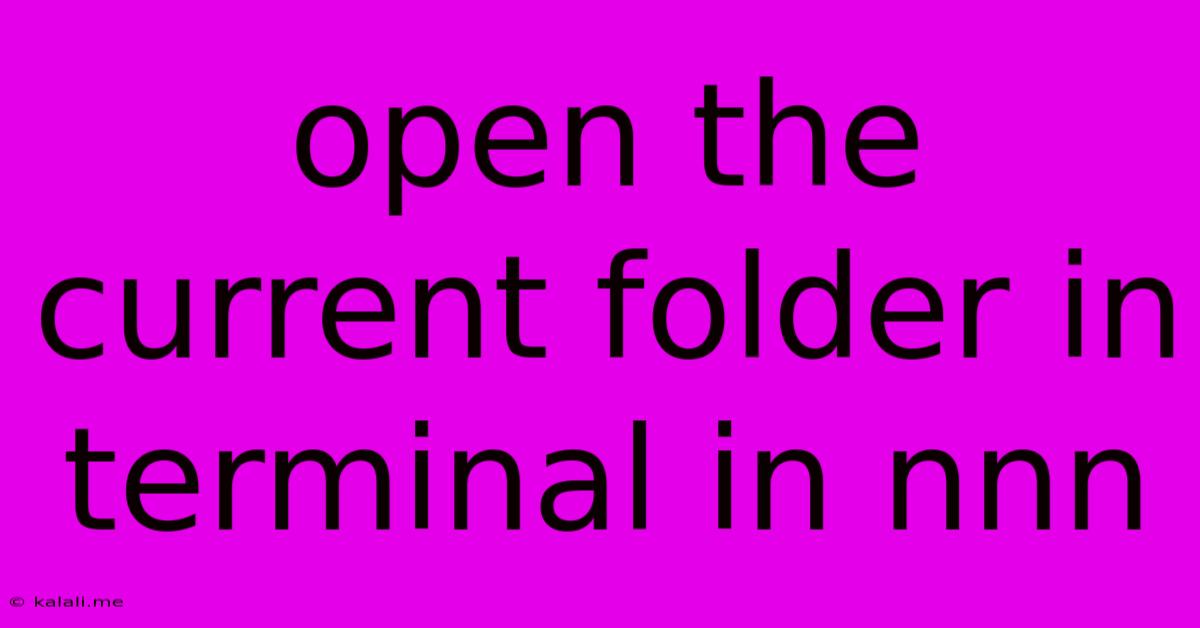Open The Current Folder In Terminal In Nnn
Kalali
Jun 08, 2025 · 3 min read

Table of Contents
Opening the Current Folder in Terminal from Nnn File Manager
Navigating files and folders is a crucial part of any computing workflow. Many users prefer the speed and efficiency of terminal-based commands, while others find the visual interface of a file manager more intuitive. The excellent file manager nnn bridges this gap, offering a streamlined text-based interface with powerful features, including the ability to quickly open the current directory in your terminal. This guide explains how to seamlessly integrate nnn with your terminal for a more efficient file management experience. We'll explore several methods, covering various terminal emulators and system configurations.
Understanding the Need for Terminal Integration
While nnn excels at browsing and managing files, sometimes you need the power and precision of the command line. Opening the current nnn directory directly into your terminal avoids the cumbersome process of manually copying and pasting paths, especially when dealing with deeply nested structures or long filenames. This integration boosts productivity and reduces the likelihood of errors.
Method 1: Using the nnn built-in command (Recommended)
The simplest and most recommended approach leverages nnn's built-in functionality. By default, nnn provides a keybinding that directly opens the current directory in the terminal. This often involves pressing a designated key combination. Consult your nnn configuration (~/.config/nnn/nnnrc) or the nnn documentation for the precise keybinding. It's typically something like t or T. This will open the current directory in your default terminal emulator.
Advantages:
- Simplicity: A single keystroke opens the directory.
- Efficiency: No need for extra commands or configuration changes (in most cases).
- Clean Integration: Seamlessly combines the graphical interface of
nnnwith the terminal.
Disadvantages:
- Keybinding Dependence: Requires knowing and using the correct keybinding.
- Terminal Emulator Dependency: The default terminal emulator might not be suitable for everyone.
Method 2: Utilizing Shell Commands within Nnn
nnn supports executing arbitrary shell commands, allowing you to open the current directory using a custom command. This is useful if the default keybinding is unavailable or inconvenient, or if you require specific terminal settings. To do this, you'd use the nnn command line interface option to execute a shell command (typically !). Then use the pwd (print working directory) command to get the current directory path within nnn.
For example, to open the current directory in konsole (a KDE terminal emulator), you might use a custom command within the nnn console like this: !konsole -e bash -c "cd $(pwd) && exec bash"
Remember to replace konsole with your preferred terminal emulator's command. This approach provides greater customization but requires a deeper understanding of shell commands.
Method 3: Setting a Custom Keybinding in Nnnrc
For even greater control, modify your nnnrc configuration file located at ~/.config/nnn/nnnrc. This file allows you to define custom keybindings. You'll need to add a line defining a keybinding that executes a command similar to the one described in Method 2, tailored to your specific terminal. Consult the nnn documentation for detailed information on configuring keybindings.
Example nnnrc entry (adjust for your terminal):
bind T exec "gnome-terminal --working-directory=$(pwd)"
This binds the T key to open the current directory in gnome-terminal.
Choosing the Right Method
The optimal method depends on your preferences and technical skills. For most users, the built-in keybinding (Method 1) offers the easiest and most efficient solution. Users needing more control or using unusual terminal emulators might find Method 2 or 3 more suitable. Remember to always consult the nnn documentation for the most up-to-date information and configuration options. This ensures a smooth and efficient workflow integrating the visual benefits of nnn with the power and flexibility of your terminal.
Latest Posts
Latest Posts
-
Why White Paint On Tree Trunks
Jun 08, 2025
-
How To Change Frame Rate Gif Photoshop
Jun 08, 2025
-
How To Call China From America
Jun 08, 2025
-
What Is Partial Based Spectral Centroid
Jun 08, 2025
-
I Am Not Satisfied With Your Reasons Rejection Job Offer
Jun 08, 2025
Related Post
Thank you for visiting our website which covers about Open The Current Folder In Terminal In Nnn . We hope the information provided has been useful to you. Feel free to contact us if you have any questions or need further assistance. See you next time and don't miss to bookmark.